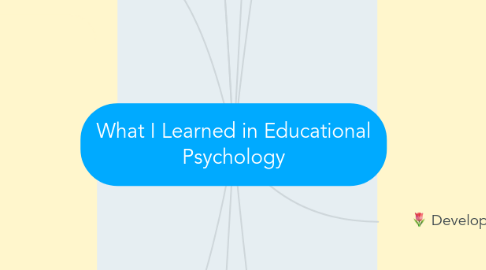
1. History of Educational Psychology
1.1. Schwabb's 4 Commonplaces of Education
1.1.1. teacher
1.1.2. curriculum
1.1.3. student
1.1.4. classroom
1.2. Thorndike, James, Dewey, Piaget, Vygotsky
1.3. Research Methods
2. Standardized Achievement Tests
2.1. EQAO
2.2. pros and cons
2.3. preparing students for test-writing
2.4. Principles for Fair Student Assessment Practices for Education in Canada
2.5. scantron
2.6. Sui Dynasty
2.7. SAT, ACT, GMAT, MCAT
2.8. competition between individual schools, school boards, provinces, and countries
2.9. validity and reliability
3. Learning Objectives, Lesson Plans and Instructional Methods
3.1. diagnostic assessment
3.2. backward design
3.3. instructional goal/learning objective
3.3.1. Bloom's taxonomy
3.3.1.1. cognitive verbs
3.3.2. Stiggins' Achievement Targets
3.4. universal instructional design
3.5. cognitive strategies
3.5.1. SOI
3.6. motivation
3.6.1. classroom tasks, instructional practices, classroom relationships (Perry, Turner & Meyer, 2012)
3.7. direct instruction
3.8. problem, project, inquiry based learning
4. Assessment
4.1. homework
4.2. purposes of assessment
4.2.1. diagnostic assessment
4.2.2. formative assessment
4.2.3. summative assessment
4.3. differentiated methods
4.4. designing questions
4.4.1. backward design
4.4.2. reliability
4.4.3. validity
4.4.4. table of specifications
4.4.4.1. knowledge
4.4.4.2. comprehension/application
4.4.4.3. analysis/synthesis/evaluation
4.5. frequency of testing
4.6. types of assessment questions
4.6.1. selected-response questions
4.6.1.1. true/false questions
4.6.1.2. matching questions
4.6.1.3. multiple-choice questions
4.6.2. constructed-response questions
4.6.2.1. short answer questions
4.6.2.2. restricted-essay/essay questions
4.6.2.2.1. rubric
4.7. authentic assessment
4.8. portfolios
4.9. effectiveness of assessment tools
4.10. feedback
5. Intelligence and Exceptional Students
5.1. Carroll's Hierarchical Model of Intelligence
5.1.1. fluid intelligence
5.1.2. crystallized intelligence
5.1.3. visual spacial reasoning
5.1.4. general intelligence
5.2. Gardner's Theory of Multiple Intellignences
5.3. Sternberg's Triarchic Theory of Intelligence
5.3.1. contextual/practical
5.3.2. experiential/creative
5.3.3. componential/analytical
5.4. nature vs. nurture debate
5.5. intelligence tests
5.6. special education
5.6.1. inclusive education
5.6.2. assessment information
5.6.3. learning and socialization
5.6.4. high incidence vs low incidence
5.6.4.1. ADHD
5.6.4.2. autism spectrum disorder
5.6.4.3. gifted students
5.6.4.4. intellectual disabilities
5.6.4.5. learning disorders
5.6.5. controversies
5.6.6. differentiated learning
5.6.7. temperment
6. Socio-Cultural Considerations
6.1. individualism vs. collectivism
6.2. differences within groups
6.3. critical consciousness
6.4. culturally responsive practice
6.5. stereotype threat
6.5.1. prejudice
6.6. socio-economic status
6.6.1. Baumrind's Parenting Styles
6.6.1.1. authoritarian
6.6.1.2. permissive
6.6.1.3. authoratative
6.7. multicultural education
6.7.1. aboriginal education
6.7.1.1. different goals
6.7.1.2. will school pay off?
6.7.1.3. empowerment
6.7.2. Banks' Dimensions of Multicultural Education
7. Planning for the School Year
7.1. Getting to Know Your Students
7.1.1. funds of knowledge
7.1.2. socio-cultural considerations
7.1.3. interests, hobbies, etc.
7.1.4. home/family situation
7.2. Diagnostic Assessment
7.3. Top Down Approach
7.4. Curriculum Planning
7.5. Teaching Approaches
7.5.1. teacher centered
7.5.2. constructivism/student centered learning
7.5.3. self regulation
7.5.4. competence/control beliefs
8. Development
8.1. physical development
8.2. different rates of development
8.3. principles of development
8.3.1. orderly and logical progression
8.3.2. gradually progressive (yet not necessarily constant) process
8.3.3. quantitative and qualitative changes
8.3.4. individuals have different rates of development
8.3.5. combination of nature and nurture
8.4. cognitive development
8.4.1. Piaget
8.4.1.1. adaptation
8.4.1.1.1. assimilation and accommodation
8.4.1.2. schemas
8.4.1.3. Four Stages of Cognitive Development
8.4.1.3.1. sensorimotor
8.4.1.3.2. preoperational
8.4.1.3.3. concrete operations
8.4.1.3.4. formal operations
8.4.2. Vyogtsky
8.4.2.1. zone of proximal development
8.4.2.2. scaffolding
8.4.3. Chomsky
8.4.3.1. language acquisition device
8.5. social development
8.5.1. fundamental psychological needs
8.5.1.1. self efficacy
8.5.1.2. self worth
8.5.1.3. relatedness
8.5.2. moral development
8.5.2.1. Kohlberg's Six Stage Theory
8.5.3. societal influences
8.5.3.1. Bronnfenbrenner's Ecological Theory
8.5.3.2. Erikson's Eight Sstages of Psychosocial Development
9. Classroom Management
9.1. dynamic classroom management
9.1.1. explicit teacher and student rules
9.1.2. proactive approach
9.1.3. students responsibilities
9.1.4. positive behavioral support
9.2. motivation
9.2.1. intrinsic
9.2.2. extrinsic
